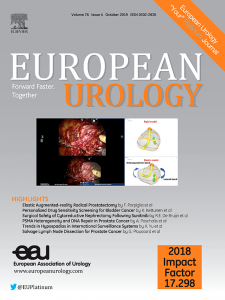新型放射性药物和泌尿生殖系统癌症治疗技术的未来
IF 25.3
1区 医学
Q1 UROLOGY & NEPHROLOGY
引用次数: 0
摘要
背景和目的本综述旨在概述最近在前瞻性 1-2 期临床试验中测试或目前用于泌尿生殖系统癌症的新型诊断和治疗放射性药物,总结进展情况和未来方向。方法按照《系统综述和荟萃分析首选报告项目》指南,使用 PubMed/MEDLINE 和 ClinicalTrials.gov 数据库对原始前瞻性研究进行了系统检索。介绍了过去 5 年中对泌尿生殖系统癌症(主要是前列腺癌)进行前瞻性研究的 27 种新型放射性药物(即未经食品药品管理局/欧洲药品管理局批准且未列入药典的药物)的诊断、治疗或治疗结果(27 种放射性药物中分别有 21 种、1 种和 5 种)。大多数是前列腺特异性膜抗原靶向药物(17/27);其他靶向药物包括胃泌素释放肽受体、碳酸酐酶 IX、Cu、前列腺六种跨膜上皮抗原 1、肿瘤相关糖蛋白 42 和尿激酶型纤溶酶原激活剂受体。正在进行的研究也证实了这一趋势。成纤维细胞活化蛋白抑制剂、PD-L1、CD8、nectin-4 和 HER2 是正在研究的其他靶点。在 22 项正在进行的治疗试验中(74 项正在进行的临床试验中),12 项正在探索α靶向疗法,5 项正在评估放射性配体疗法与其他疗法的组合。我们证实了放射性药物的安全性(无论其诊断/治疗目的如何),并在泌尿生殖系统癌症的诊断准确性和疗效方面取得了可喜的成果。结论和临床意义泌尿生殖系统癌症的放射性药物治疗方法仍在不断扩展,这反映了人们对改善肿瘤检测和治疗的高度重视,这可能会影响未来对整个疾病谱的管理,并有可能改善患者护理和预后。本文章由计算机程序翻译,如有差异,请以英文原文为准。
Novel Radiopharmaceuticals and Future of Theranostics in Genitourinary Cancers
Background and objective
This review aims to provide an overview of novel diagnostic and therapeutic radiopharmaceuticals tested recently or used currently in genitourinary cancers within prospective phase 1–2 clinical trials, summarizing progresses and future directions.
Methods
A systematic search was conducted using the PubMed/MEDLINE and ClinicalTrials.gov databases for original prospective research studies following the Preferred Reporting Items for Systematic Reviews and Meta-analyses guidelines.
Key findings and limitations
Forty-six papers were systematically reviewed; 74 ongoing clinical trials were identified. The results of 27 novel radiopharmaceuticals (ie, not approved by the Food and Drug Administration/European Medicines Agency and not listed in the Pharmacopeia) prospectively investigated in genitourinary cancers, mostly prostate, for diagnostic, theranostic, or therapeutic purposes (21, one, and five of the 27 radiopharmaceuticals, respectively) over the past 5 yr were presented. Most were prostate-specific membrane antigen–targeting agents (17/27); other targets included gastrin-releasing peptide receptor, carbonic anhydrase IX, Cu, six transmembrane epithelial antigen of the prostate 1, tumor-associated glycoprotein 42, and urokinase-type plasminogen activator receptor. Ongoing research confirms the same trend. Fibroblast activation protein inhibitor, PD-L1, CD8, nectin-4, and HER2 are other targets under investigation. Among the 22 ongoing therapeutic trials (out of the 74 ongoing clinical trials), targeted alpha therapy is being explored in 12, and five are evaluating combinations of radioligand therapy with other treatments. We confirmed the safety of radiopharmaceuticals (regardless of the diagnostic/therapeutic purpose) and showed promising results in terms of diagnostic accuracy and therapeutic efficacy in genitourinary cancers.
Conclusions and clinical implications
There continues to be expansion in radiopharmaceutical approaches to genitourinary cancers, reflecting a strong emphasis on improving tumor detection and treatment, which will likely impact future management across the disease spectrum, with the potential for improved patient care and outcomes.
求助全文
通过发布文献求助,成功后即可免费获取论文全文。
去求助
来源期刊

European urology
医学-泌尿学与肾脏学
CiteScore
43.00
自引率
2.60%
发文量
1753
审稿时长
23 days
期刊介绍:
European Urology is a peer-reviewed journal that publishes original articles and reviews on a broad spectrum of urological issues. Covering topics such as oncology, impotence, infertility, pediatrics, lithiasis and endourology, the journal also highlights recent advances in techniques, instrumentation, surgery, and pediatric urology. This comprehensive approach provides readers with an in-depth guide to international developments in urology.
 求助内容:
求助内容: 应助结果提醒方式:
应助结果提醒方式:


